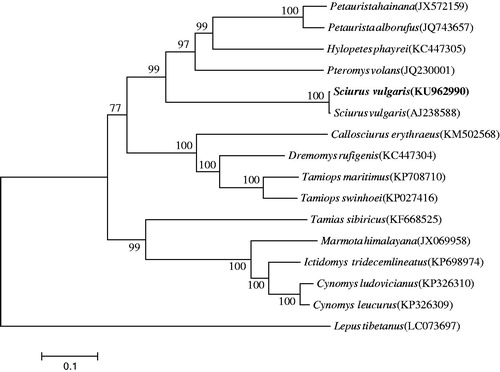Abstract
The mitogenome of the Korean S. vulgaris is a circular molecule of 16,511 bp, consisting of a control region and a conserved set of 37 genes containing 13 protein-coding genes (PCGs), 22 tRNA genes and 2 rRNA genes (12S rRNA and 16S rRNA). The mitogenome of the Korean S. vulgaris is AT-biased, with a nucleotide composition of 32.0% A, 30.9% T, 12.6% G and 24.5% C. The phylogenetic analysis revealed that the Korean red squirrel S. vulgaris is well grouped with the European red squirrel S. vulgaris and formed a sister clade to the Old World flying squirrels of the genus Pteromys.
The red squirrels of Sciurus vulgaris (Sciuridae), also known as the Eurasian red squirrel, are distributed across the forests of the Palearctic from the western Europe and the UK eastward to the pacific coast of East Asia (Oshida et al. Citation2009; Liu et al. Citation2014). In South Korea, the red squirrels are widely distributed across coniferous forests and temperate broadleaf woodland. We sequenced and characterized the complete mitogenome of the Korean S. vulgaris. A tissue sample for genomic DNA extraction was collected from a red squirrel individual caught around an agricultural region in Odaesan National Park (N37 43 23.4, E128 36 03.8), South Korea. The voucher specimen (SCSCVU-1) was deposited in the National Park Research Institute, Korea National Park Service. Genomic DNA extraction, PCR and gene annotation were conducted according to the previous studies (Yoon et al. Citation2013; Jeon and Park Citation2015; Rahman et al. Citation2016). A previously published mitogenome of the European S. vulgaris (AJ238588) was used as reference for gene annotation and primer design for PCR amplification of the Korean S. vulgaris mitogenome. Phylogenetic tree was constructed using maximum-likelihood (ML) procedures implemented in MEGA6 (Tamura et al. Citation2013).
The complete mitogenome (KU962990) of the Korean S. vulgaris contains 16,511 bp in length, which consists of a control region (CR) and a conserved set of 37 vertebrate mitochondrial genes including 13 PCGs, 22 tRNA genes and 2 rRNA genes (12S rRNA and 16S rRNA). The order and orientation of these genes are identical to those of other mammals (Kim and Park Citation2012; Yoon et al. Citation2013; Nam et al. Citation2015).
The whole mitogenome of the Korean S. vulgaris is AT-biased, with a nucleotide composition of 32.0% A, 30.9% T, 12.6% G and 24.5% C. Total length of the 13 mitochondrial PCGs of the Korean S. vulgaris is 11,367 bp long, with the exclusion of stop codons, which encode 3789 amino acids. Lengths of two rRNA genes (12s rRNA and 16s rRNA) were 967 bp and 1579 bp long, respectively. As rRNA genes in other mammal mitogenomes (Kim and Park Citation2012; Yoon et al. Citation2013; Nam et al. Citation2015), 12S rRNA and 16S rRNAs of the Korean S. vulgaris mitogenome are located between tRNAPhe and tRNALeu(UUR) and separated by tRNAVal. There are a total of 22 tRNA genes for transferring 20 amino acids, ranging in size from 59 bp (tRNASer(AGY)) to 75 bp (tRNALeu(UUR)). The tRNA genes include two leucine-tRNA genes (tRNALeu(UUR) and tRNALeu(CUN)) and two serine-tRNA genes (tRNASer(AGY) and tRNASer(UCN)). The mitochondrial OR is 32 bp long and is located between tRNAAsn and tRNACys in the WANCY region, which consists of a cluster of five tRNA genes (tRNATrp, tRNAAla, tRNAAsn, tRNACys and tRNATyr). Mitochondrial CR, which is located between tRNAPro and tRNAPhe, is 1058 bp long.
The phylogenetic analysis revealed that the Korean red squirrel S. vulgaris is well grouped with the European red squirrel S. vulgaris and formed a sister clade to the Old World flying squirrels of the genus Pteromys ().
Figure 1. The phylogenetic relationship of S. vulgaris and its allied species inferred from maximum-likelihood analysis based on mitogenome sequences. The ML tree was generated using the GTR + G + I model, and the robustness of the tree was tested with 1000 bootstrap. The numbers on the branches indicate bootstrap values.

Disclosure statement
The authors declare no conflict of interest. The authors alone are responsible for the content and writing of this article.
Additional information
Funding
References
- Jeon MG, Park YC. 2015. The complete mitogenome of the wood-feeding cockroach Cryptocercus kyebangensis (Blattodea: Cryptocercidae) and phylogenetic relations among cockroach families. Anim Cells Syst. 19:432–438.
- Kim HR, Park YC. 2012. The complete mitochondrial genome of the striped field mouse, Apodemus agrarius (Rodentia, Murinae) from Korea. Mitochondrial DNA. 23:145–147.
- Liu Z, Li B, Ma Z, Zheng D, Xu Y. 2014. Phylogeography and genetic diversity of the red squirrel (Sciurus vulgaris) in China: implications for the species’ postglacial expansion history. Mammal Biol. 79:247–253.
- Nam TW, Kim HR, Cho JY, Park YC. 2015. Complete mitochondrial genome of a large-footed bat, Myotis macrodactylus (Vespertilionidae). Mitochondrial DNA. 26:661–662.
- Oshida T, Arslan A, Noda M. 2009. Phylogenetic relationships among the old world Sciurus squirrels. Folia Zool. 58:14–25.
- Rahman MM, Yoon KB, Kim JY, Hussin MZ, Park YC. 2016. Complete mitochondrial genome sequence of the Indian pipistrelle Pipistrellus coromandra (Vespertilioninae). Anim Cells Syst. 20:86–94.
- Tamura K, Stecher G, Peterson D, Filipski A, Kumar S. 2013. MEGA6: molecular evolutionary genetics analysis version 6.0. Mol Biol Evol. 30:2725–2729.
- Yoon KB, Cho JY, Park YC. 2013. Complete mitochondrial genome of the Korean ikonnikov's bat Myotis ikonnikovi (Chiroptera: Vespertilionidae). Mitochondrial DNA. 26:274–275.
